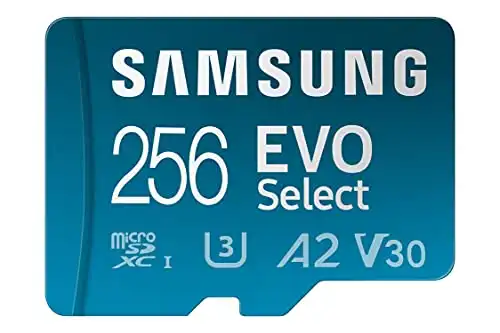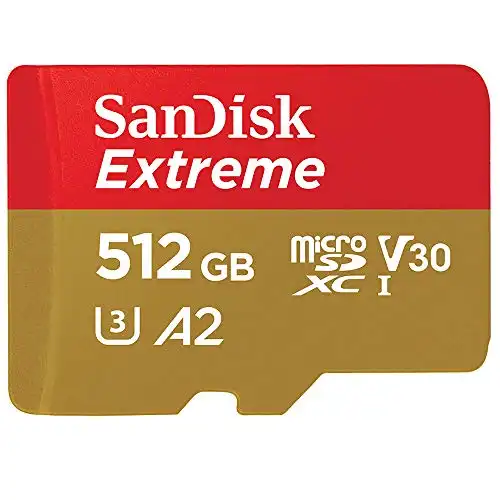4K video is the successor to the long-beloved high-definition video and its quality is shockingly crisp.
Why bother going to the Grand Canyon, Redwood National Park, or anywhere else when it lacks the visual quality that you can find in a crisp 4k National Geographic clip? We are getting to a point where the recorded footage of an event looks better than our own eyes can produce — but it comes at a cost that feels almost impossible to accommodate.
4k video is a bulky, cumbersome storage killer and that is putting it somewhat mildly. If you want to record something with over eight million pixels of sensational quality, you are going to have to dig deep into your storage wallet to do so.
Get your seat primed and ready for uncomfortable shifting as we take a look at just how bulky an SD card you need for a 4k video.
We will go over how much space 4k takes up and how much time of 4k video you can get from the different sizes of SD cards on the market today.
What Size SD Card Do You Need For 4K Video?
Prior to the incredibly impressive 4K resolution that has become synonymous with visual quality, there was 1080p or High-definition video.
Compared to the previous standard, 4k offers almost quadruple the pixel quality that its predecessor did. So while it is without question a pretty sizable investment on your storage, if you look at the two by comparison you start to see why it takes such a toll on your SD card.
Unobstructed, non-compressed 4k video will take up somewhere around 110 gigabytes of storage per hour.
While we can never be one hundred percent accurate on the total storage taken up from 4k video (several factors can fluctuate the storage size of the video) we can give a general idea of what will be ideal for those looking to shoot longer video clips in 4k.
So while you will never have the definitive answer we all want for how much space is required, you can comfortably know what SD cards will not benefit you.
What Makes Up The Size of 4k Videos?
For those reading this, they might be scratching their heads wondering why different 4k footage that both measure out to five minutes might weigh down an SD card differently. Well, to make a very long and detailed story short, there are a few factors we have to look at.
The frame rate is the first, it is the number of images in a video clip. This is often shortened to FPS or frames per second and the more you have, the more space you will need.
The second culprit is going to be the bitrate of the video you are filming. Bitrate is measured in Mbps (megabytes per second) and affects the overall quality of the video. If the bitrate is higher – 400 Mbps for instance – it will stuff up a lot of your SD card with very high-quality video. Inversely, the lower the bitrate the more clunky the video will be and the more space you will save.
Finally, you have to consider if the footage has been compressed or not. Compression helps keep the file size of videos more compact, so raw footage is naturally going to be a lot bulkier by comparison. Most cameras are not going to offer compression methods unless they are fairly expensive or higher-end, though some do offer compression options.
Is a 64GB SD Card Good Enough for 4K Video?
This size feels like it has a lot of contentious ideas over whether or not it is suitable for longer 4k videos, and some of the answers have felt a bit misleading.
While technically speaking there are some instances where 4k video can film easily up to an hour on 64 gigabytes of storage, it is also important to know that 4k can exceed this allotted storage just as easily.
So while certain articles will recommend going with a 64 gigabyte SD card or higher, I would suggest starting at 128 gigabytes and then consider more storage space from there.
~~~ Our Top 64GB Micro SD Card: SanDisk Ultra (Check Price) ~~~
Is a 128GB SD Card Good Enough for 4K Video?
Overall, I would say a 128GB SD card would serve you well, especially if you don’t plan to film multiple 4k videos.
Opinions on this differ, but in my subjective view, this is the bare minimum of what someone should look for when purchasing an SD card for their camera.
A lot of things go into just how much 4k your SD can hold including frames per second, the codec your camera uses, compression, and of course the bit rate. Keeping this in mind, the estimated amount of 4k video that a 128GB card can hold is somewhere between 42 – 304 minutes (you can start to see why 64GB is not a great choice).
This is a size that will benefit someone who uses 4k sparingly and rarely needs more than thirty minutes or more of 4k video.
If you go above that, there will be times that you struggle with storage or run out entirely, which inadvertently creates a power struggle in your SD card for what can stay and what gets cut. If you are trying to film something transient or on a time constraint, this can prove disastrous.
~~~ Our Top 128GB Micro SD Card: SanDisk Extreme (Check Price) ~~~
Is a 256GB SD Card Good Enough for 4K Video?
When we start to look at the price of these cards versus how much storage we need to film 4k, 256 feels like the best middle ground you will find.
Doubling the approximate storage space that 128GB has (256GB measures out to 84 – 608 minutes) you are more than likely to get your money’s worth with this card. Even at the highest bit rate of 400 Mbps, you still get a good bit over an hour of footage which is exceptional.
~~~ Our Top 256GB Micro SD Card: Samsung Evo Select (Check Price) ~~~
512GB Cards and Higher
While 512 GBs should be more than enough for any 4k needs one has (168 minutes of 4k, if not much more), forward-thinking folks might want to get the more spacious SD cards for future purchases and upgrades.
Ten years ago most folks would have a hard time imagining the 64-gigabyte SD card ever being obsolete, and yet here we are.
If you have a few extra bucks, a large ambition for 4k resolution videos, and your eyes on the future, buying a bigger SD card now could save you down the line as the video on your camera begins to take up more space.
With that said, most of these products are overkill for someone looking to shoot little more than an hour of 4k.
~~ Our Top High-Capacity Micro SD Card: SanDisk 512GB Extreme (Check Price) ~~
Final Thoughts
4k video is the current standard for video resolution and will likely be around for a number of years before it too is eventually dethroned.
While it is breathtaking to experience, all good things come with their own form of drawbacks — and outstanding video quality is no exception.
For those looking for a good SD card to film 4k in, shoot for 128GB or above. While 64 gigabytes was exceptional back in 2011, unfortunately, it is becoming obsolete at a speed most of us can barely keep up with.
FAQs
Can I reduce the size of my 4K videos without losing quality?
Yes, you can reduce the size of your 4K videos without losing too much quality by using a process called compression. Compression algorithms work by removing unnecessary data from the video file, which reduces its size. However, it’s important to remember that excessive compression can result in a noticeable loss of video quality.
Can I use a 4K video on platforms that don’t support 4K?
Yes, you can. However, the video will be automatically downscaled to match the platform’s maximum resolution. Despite the downscaling, your video may still look better than if it had been shot in a lower resolution.
Does shooting in 4K use more battery?
Generally, yes. Shooting in 4K requires more processing power, which can drain your camera’s battery faster.



